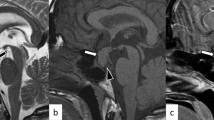Abstract
Objective
To analyse the clinical and radiological characteristics of pituitary stalk interruption syndrome (PSIS).
Methods
A retrospective analysis of confirmed cases of PSIS was performed. The development of new pituitary hormonal deficiencies and response to recombinant human growth hormone (rhGH) therapy were assessed during follow-up.
Results
This study included 14 children (10 boys) of PSIS with median (range) age of 12.15 years (2 months–18 years). Short stature was the most common presentation (n = 13), and micropenis (n = 4), cleft lip (n = 1) and single central incisor (n = 1) were other midline defects. Growth hormone (GH) deficiency was present in 14 children and 7 of them also had multiple pituitary hormone deficiencies at baseline. Central hypothyroidism (n = 5), secondary adrenal deficiency (n = 4) and gonadotropin deficiencies (n = 2) were also seen. All children received rhGH. The mean height gain on follow-up was 12.78 cm in first year (n = 14), 6.5 cm in second year (n = 8) and 4.07 cm in third year (n = 7) of rhGH therapy. Four children developed additional pituitary hormone deficiency on follow-up.
Conclusion
Short stature with isolated GH deficiency was the most common presentation of PSIS that showed good response to rhGH therapy.
Similar content being viewed by others
References
Fujisawa I, Kikuchi K, Nishimura K, et al. Transection of the pituitary stalk: development of an ectopic posterior lobe assessed with MR imaging. Radiology. 1987;165:487–9.
El Chehadeh-Djebbar S, Callier P, Masurel-Paulet A, et al. 17q21.31 microdeletion in a patient with pituitary stalk interruption syndrome. Eur J Med Genet. 2011;54:369–73.
Shizume K, Harada Y, Ibayashi H, Kumahara Y, Shimizu N. Survey studies on pituitary diseases in Japan. Endocrinol Jpn. 1977;24:139–47.
Wang CZ, Guo LL, Han BY, Su X, Guo QH, Mu YM. Pituitary Stalk interruption syndrome: from clinical findings to pathogenesis. J Neuroendocrinol. 2017;29:10.1111.
Yadav P, Singhal S, Chauhan S, Harit S. MRI evaluation of size and shape of normal pituitary gland: Age and sex related changes. J Clin DiagnRes. 2017;11:1–4.
Satogami N, Miki Y, Koyama T, Kataoka M, Togashi K. Normal pituitary stalk: high-resolution MR imaging at 3T. AJNR Am J Neuroradiol. 2010;31:355–9.
Aaronson IA. Micropenis: medical and surgical implications. J Urol. 1994;152:4–14.
Diwaker C, Thadani P, Memon SS, et al. Pituitary stalk interruption syndrome: phenotype, predictors, and pathophysiology of perinatal events. Pituitary. 2022;25:645–52.
Guo Q, Yang Y, Mu Y, et al. Pituitary stalk interruption syndrome in Chinese people: Clinical characteristic analysis of 55 cases. PLoS One. 2013;8:e53579.
Bar C, Zadro C, Diene G, et al. Pituitary stalk interruption syndrome from infancy to adulthood: Clinical, hormonal, and radiological assessment according to the initial presentation. PLoS One. 2015;10:e0142354.
Secco A, Allegri AE, di Iorgi N, et al. Posterior pituitary (PP) evaluation in patients with anterior pituitary defect associated with ectopic PP and septo-optic dysplasia. Eur J Endocrinol. 2011;165: 411–20.
Sridhar S, Raja BR, Priyanka R, Natarajan S, Soundararajan S, Natarajan V. Clinico-radiological correlation of pituitary stalk interruption syndrome in children with growth hormone deficiency. Pituitary. 2023;11:1–7.
Pham LL, Lemaire P, Harroche A, Souberbielle JC, Brauner R. Pituitary stalk interruption syndrome in 53 postpuberal patients: Factors influencing the heterogeneity of its presentation. PLoS One. 2013;8:e53189.
Maghnie M, Larizza D, Triulzi F, Sampaolo P, Scotti G, Severi F. Hypopituitarism and stalk agenesis: a congenital syndrome worsened by breech delivery? Horm Res. 1991;35:104–8.
Tauber M, Chevrel J, Diene G, et al. Long-term evolution of endocrine disorders and effect of GH therapy in 35 patients with pituitary stalk interruption syndrome. Horm Res. 2005;64:266–73.
Funding
Funding: None
Author information
Authors and Affiliations
Contributions
Contributors: All the authors were involved in work conception, data acquisition, data analysis and interpretation of data, drafting and revision of manuscript.
Corresponding author
Ethics declarations
Ethical clearance: Institute Ethics Committee, Gauhati Medical College; No. MC 190/2007/Pt-II/April-2023/17, dated June 23, 2023.
Competing interest: None stated.
Rights and permissions
About this article
Cite this article
Ravichandran, R., Saikia, U.K., Bhuyan, A.K. et al. Pituitary Stalk Interruption Syndrome: Analysis of Response to Growth Hormone Therapy. Indian Pediatr 61, 154–157 (2024). https://doi.org/10.1007/s13312-024-3111-6
Received:
Revised:
Accepted:
Published:
Issue Date:
DOI: https://doi.org/10.1007/s13312-024-3111-6




